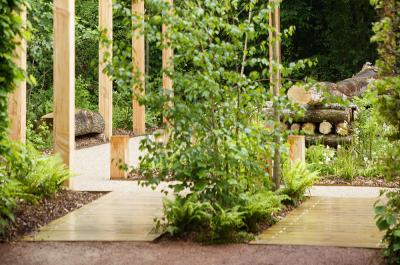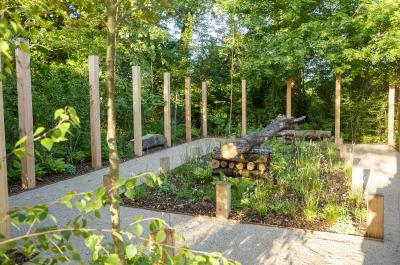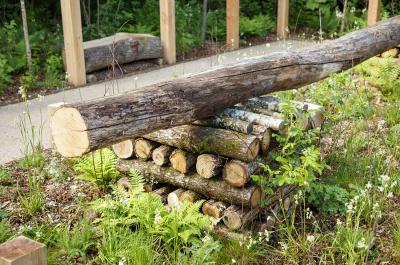12. Le Bois Sacré

At the heart of the forest, a fallen tree plays havoc with the previously established order. Its demise is however just one stage in the long life of the specimens found in the woods, a local and solitary sound, a muffled thud in the midst of the other trees. Life goes on. Woodpeckers, saprophages, wood insects, bacteria and fungi come to attack the bark and heartwood one after another, making holes, digging, breaking down and digesting. This swarming life progressively transfers the energy from the fallen or uprooted tree into the soil and surrounding environment. In the clearing created by this incident, seeds that were for a long time forgotten under the humus, awaken and grow, filling the space and fighting to reach the sun’s rays. Surrounded by a gallery of solid wood posts, the clearing resembles a plant-based cloister where the uprooted tree is sanctified. The isolated tree is spectacular, a heaven-sent representation of the forest around it. For beyond the gallery, the edge of a dense, protective forest is developing. This established, stable, intimate forest is here to stay. It reminds us that we have for a long time lived alongside, feared or revered the forests before using their resources. It also reminds us that they feed us, keep us warm, protect us, and watch us grow and die. They also make us dream. Le Bois Sacré (The sacred wood) is an interlude, an invitation to take a moment for contemplation, discovery and astonishment. The death of a tree does not obscure the life within the forest, quite the opposite in fact!
DESIGNER

Philippe Allignet is a gardener, landscape architect and teacher. He divides his time between the Netherlands, Belgium and France and is fascinated by garden design and large landscape. Having gained a French vocational qualification (BTS) in landscaping, he studied at the School of Nature and Landscape in Blois and then at the Academy of Architecture in Amsterdam, where he now teaches. The brief time he spent at Atelier Jacqueline Osty & Associés helped develop his fascination for the design of public spaces and the image that they portray of nature. After that he worked at H+N+S+ Landschapsarchitecten and OKRA (the Netherlands). At the same time, he founded his own studio, LLA, in 2020. This experience only confirmed his passion, on the one hand for the vast regions that call our landscapes into question, the tension that prevails between natural and environmental processes and anthropic uses of our society to design the landscapes of the future, and on the other hand, on the smaller scale of the gardens and public spaces in our towns and countryside, courtyards and private gardens. He enjoys exchanging ideas and practices between these two scales, playing with artistic, ecological and social dimensions to create spaces that are highly visual, rich and diversified. They all carry a subtle yet clear message about the evolution of our practices and of the way we look at nature.


